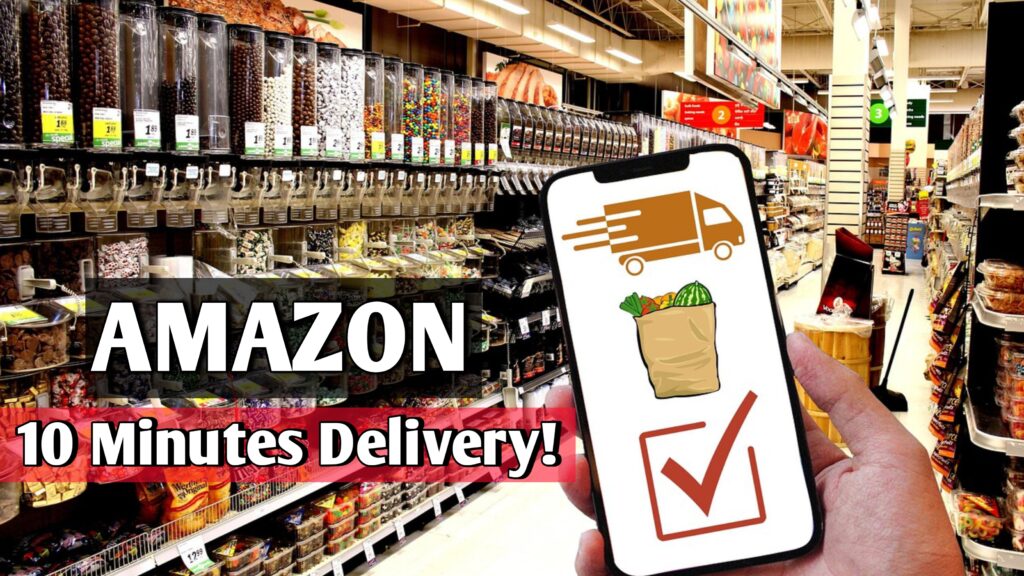
In a major push to dominate the quick commerce segment, Amazon launches 10 minute delivery in Delhi after its successful pilot in Bengaluru. This lightning-fast service is currently available in select PIN codes of the capital and is designed to cater to the increasing demand for ultra-fast grocery and daily essential deliveries. With this move, Amazon has entered direct competition with platforms like Blinkit, Zepto, and Swiggy Instamart.
Table of Contents
Quick Commerce War: Amazon Enters the Fast Lane
With the Indian e-commerce market evolving rapidly, the focus has shifted from next-day delivery to deliveries in under 30, even 10 minutes. Amazon launches 10 minute delivery in Delhi as part of this aggressive strategy to grab a bigger slice of the urban consumer base. The company has reportedly partnered with local dark stores and is utilizing a hyperlocal warehouse model to ensure quick fulfillment of orders.
The service promises to deliver essential items like snacks, packaged food, beverages, personal care, and household products within just 10 minutes of placing the order. It is currently live in areas such as Lajpat Nagar, Saket, Malviya Nagar, and Hauz Khas, with plans to expand across more Delhi localities in the coming weeks.
Why 10-Minute Delivery Is a Game Changer
In metropolitan cities like Delhi, convenience and speed are everything. With increasing competition, Amazon’s move to introduce this service is not just about customer satisfaction—it’s also about maintaining market dominance. Amazon launches 10 minute delivery in Delhi to meet the expectations of customers who value instant gratification and have limited time.
By integrating AI-driven demand forecasting, route optimization, and real-time inventory tracking, Amazon aims to make this ambitious delivery timeline sustainable. This technology-backed approach could very well set a new benchmark in the industry.
Impact on the Market and Competitors
The entry of a global player like Amazon into the 10-minute delivery space is likely to shake up India’s quick commerce industry. Companies like Zepto and Blinkit, which built their business models around speed, will now have to compete not just on delivery time, but also on price, product range, and service reliability.
With its financial muscle, robust logistics network, and trust among Indian consumers, Amazon launches 10 minute delivery in Delhi to firmly plant its flag in a sector that’s expected to grow exponentially in the next 2–3 years.
Customer Response and Early Feedback
Early users of the service in Delhi have responded positively, praising Amazon’s reliability and ease of use. Customers have noted that the app interface clearly displays eligible products for 10-minute delivery, and live tracking ensures transparency throughout the process. Several users shared on social media that their orders arrived within 8–9 minutes—surpassing expectations and giving tough competition to Blinkit and Zepto. By focusing on curated essentials and optimizing store proximity, Amazon launches 10 minute delivery in Delhi with a customer-first approach that’s gaining traction quickly.
Challenges Ahead for Amazon’s Quick Delivery Model
Despite the excitement, this rapid delivery model is not without challenges. Managing real-time logistics, traffic unpredictability, and maintaining stock accuracy can strain operations. There’s also growing concern about the pressure such fast delivery places on delivery personnel. Amazon, however, has stated it is committed to fair delivery practices and safe working conditions. As Amazon launches 10 minute delivery in Delhi, the company must strike a balance between speed, efficiency, and worker well-being to ensure long-term success.
Conclusion
The announcement that Amazon launches 10 minute delivery in Delhi is a clear sign of the company’s intent to lead the next wave of e-commerce innovation in India. As it scales this offering across other cities, Amazon is not only speeding up deliveries but also reshaping consumer behavior. The future of shopping may very well lie in the next 10 minutes.
Do Follow for daily news.
